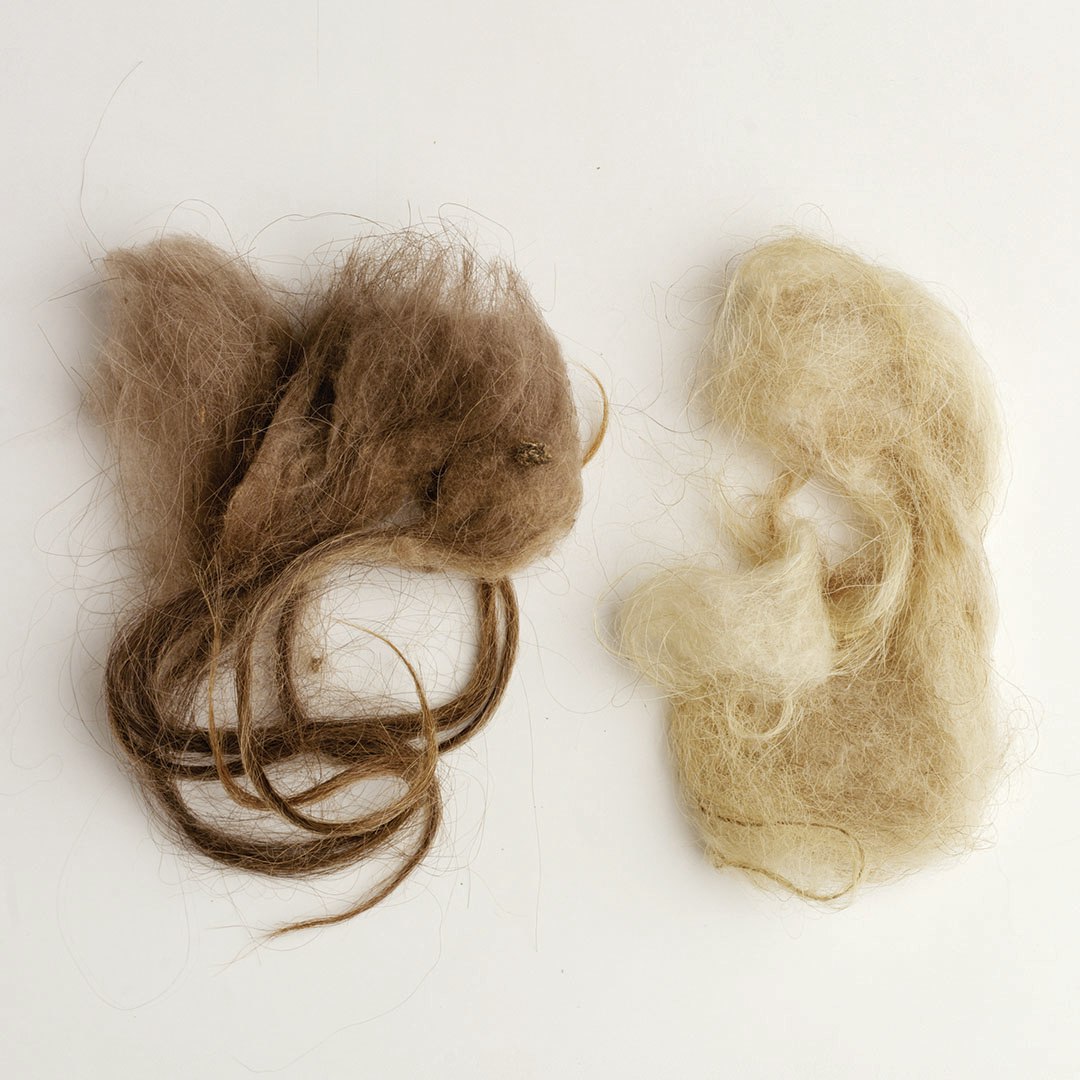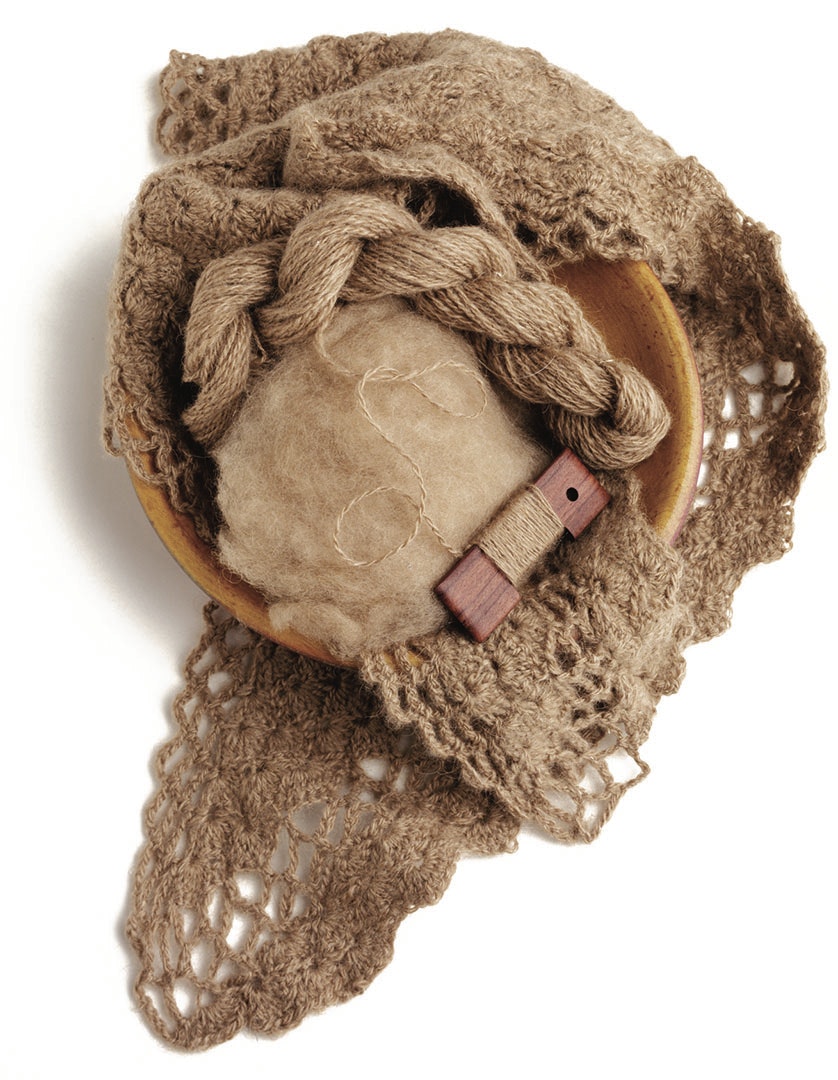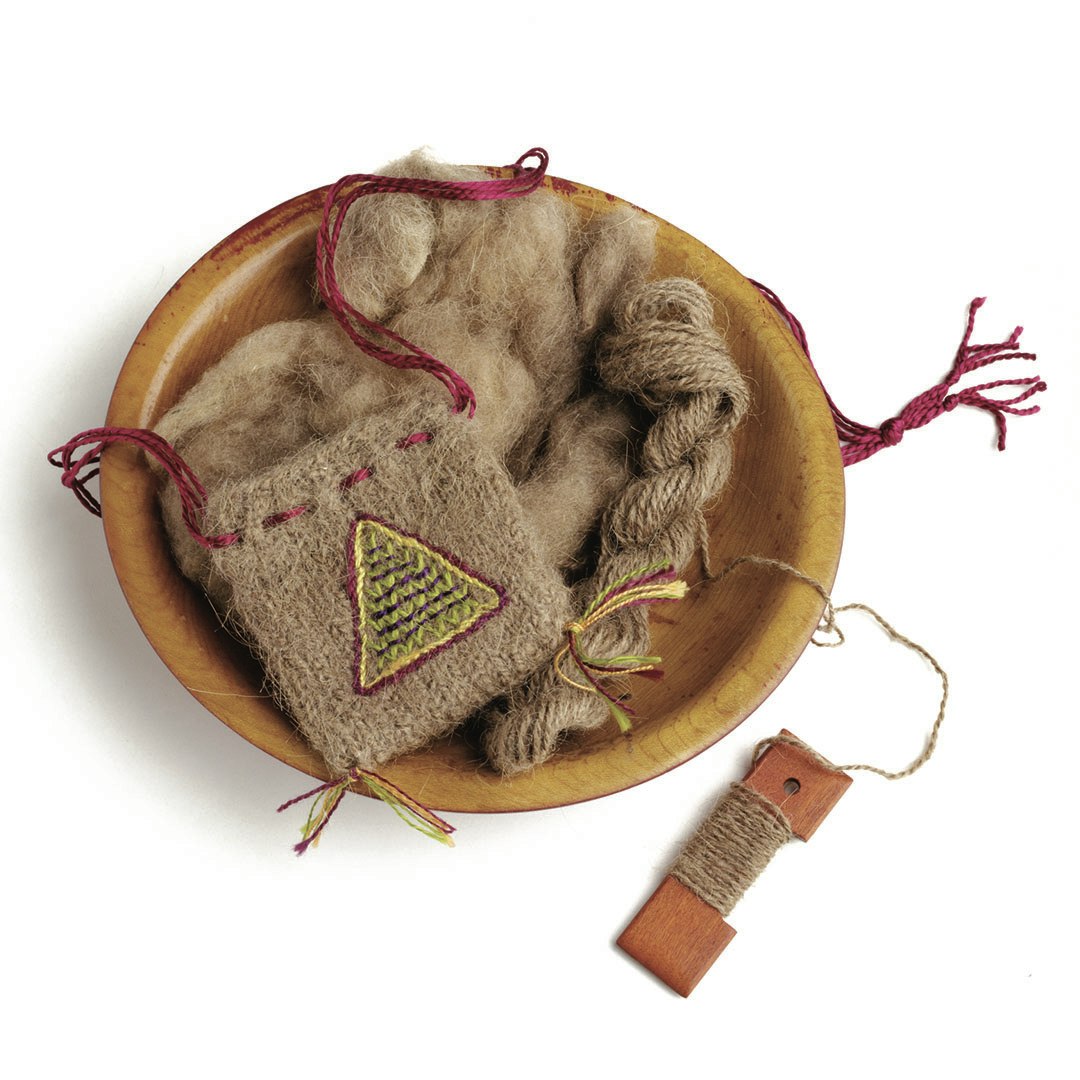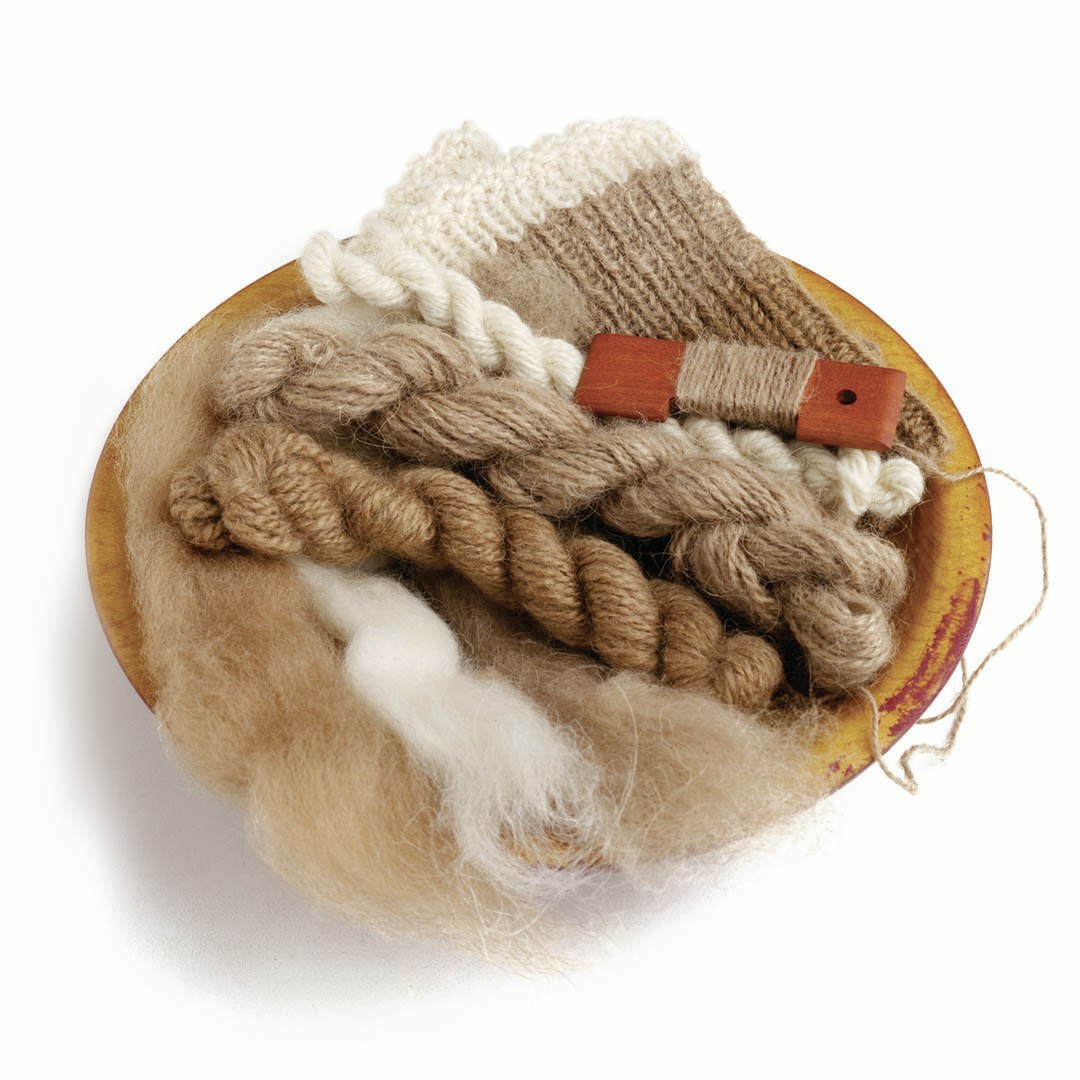The first time a box of camel fiber arrived in the mail for me, I opened the box, stuck my hand into the middle of the fiber, and thought, “This is so warm and cozy.” I couldn’t wait to spin that fiber. It was not just very nice, but special, because it came from a friend’s camels. She is a spinner and knitter and is careful to remove the fibers at the optimum time and to clean and process them well. Although there is a greater mix of fiber diameters in her raw and processed fibers than in commercially processed batts and top, the variation gives the spinner a better sense of traditionally made camel yarns and products.
Camel Characteristics
Bactrian camels have two humps and are found primarily in Mongolia and China. Their relatives, the one-hump dromedary camels, live in the Middle East. Camels are large animals, standing 6 to 7 feet high at the shoulder and weighing 1,300 to 1,800 pounds. Although both types produce usable fiber, the Bactrians are the source for the soft down we associate with fine camel hair garments. Their fiber naturally sheds and can be combed away or gathered as it falls.
Camels have been domesticated for at least 3,000 years, serving as transport animals and providing fiber, milk, meat, and leather. Camels are legendary for their endurance and live twenty-five to forty years. According to the Oklahoma State University animal breeds website, “[Dromedary] camels can tolerate extremely hot weather. They can suffer thirst, going without watering for seven to eight days. . . . The camel can travel 25–40 km per day for one month. A load of 330 pounds can be carried for seven to eight hours a day.” Bactrian camels are adapted for colder climates and can get sunburned in the summer after their wool has shed. The camel humps, by the way, store fat, not water.
Camels are still essential animals for nomad groups in western China and Mongolia. Wild Bactrian camels are very rare, with an estimated 300 to 1,000 left in the Gobi Desert. For a story about attempts to find and record the wild camels of the Gobi, see John Hare’s book listed in Resources. Additionally, a June 16, 2007, report on National Public Radio described the conditions of formerly domesticated dromedary camels now wild in Australia. Domesticated Bactrian camels can also be found in New Zealand, Afghanistan, Tibet, and a few reside in the United States.
Qualities of Bactrian Camel Fiber
While the website for the Cashmere and Camel Hair Manufacturers states that Bactrian camels produce as much as 17 to 22 pounds of fiber annually, other sources cite amounts as low as 5 pounds. The higher amounts probably include both hair and down. Dana Locken, who raises camels in South Dakota, estimates that her adult Bactrian camels produce about 5 pounds of down and 15 to 20 pounds of hair annually.
The outer coat and mane hair is long (12 inches or more) and coarse. It protects the animal from the elements, shedding dirt and water. The fine undercoat is much shorter, averaging 1 to 5 inches long, although it usually measures less than 3 inches in length. Some of the fiber shortness in commercial camel preparations may result from the dehairing process. The micron counts (fiber diameter) for camel fiber have a huge range. While the down averages 20 to 23 microns (similar to Merino wool), it can be as fine as the finest cashmere. Samples from some United States Bactrian camel hair that had all the outer coat fibers removed ranged from 6 to 120 microns, with most of the sample measuring 18 to 19 microns. Camel hair has some crimp and a small amount of elasticity.
Camel hair is, generally, camel colored (a medium reddish brown) but anything from creamy white to almost black can be found within the camel population. To see the spectrum of colors at one time, check out the film Lawrence of Arabia and pay attention during the battle scene with hundreds of camels rushing by. (The rest of the movie is also worth watching.)
Preparing Camel Fiber
The amount of preparation needed depends on the form of camel fiber you’ve obtained. Most of the camel fiber available for handspinning is already dehaired, cleaned, and processed into a batt, roving, or top. When working with the fiber in batt form (a cloud of carded fiber), I simply peel off thin layers of fiber. Rovings (strands of carded fiber with a small amount of twist) and top (strands of long fibers in parallel arrangement) require no further preparation although they are sometimes easier to spin when split into narrower strips. Because the camel fiber is short, thin strands of roving or top will probably drift apart if you try to predraft. You can also prepare for a lightweight yarn by handcarding the down fiber from any form into rolags.
Raw camel fiber takes more preparation. It can contain some dirt and grit in addition to vegetable matter. I recommend soaking the fiber (placed in a nylon net bag) in warm water for about thirty minutes to dissolve any dirt clumps and to remove some of the grit. The water can go onto the lawn if there aren’t any undesirable plant seeds mixed in. The fiber can then be washed as you would wool in warm water and a small amount of woolwash. Rinse in same temperature water, squeeze or centrifuge out excess water, and lay the fiber out to dry. Cover the fiber with rust-proof window screening if you are drying it outside on a breezy day. After drying, the camel down can be handcarded, drumcarded, or combed with minicombs. Hair can be combed on Viking combs (one row of long, thick tines) or aligned by hand to spin from the fold or from the ends.
No matter how you prepare raw camel fiber, do so outside or well away from food preparation and eating areas. Vacuum or sweep well afterwards.

Bactrian camel mane hair (left); Bactrian camel hair (right).
Spinning Camel
Spinning the outer coat of the camel is not something most spinners are interested in. However, should you want to try some, the easiest approach is to open the fibers by hand and spin either from the fold or from a corner of the cut end so that you can work across the width of the lock. Since the fibers are long, hold your hands farther apart than usual or you may not be able to draft easily. This fiber is strong and won’t need much twist. Yarn from the outer coat makes hefty rugs and strong rope.
The fiber most spinners want is the softest and finest camel down. If possible, get samples from several sources to find the quality you want and can afford. A small amount goes a long way and can be stretched by blending. Camel/silk blended tops are easy to obtain and lovely to spin. Baby camel top or roving will be very soft, but I have seen some top with just enough not-so-fine hair that it will feel scratchy if spun with too much twist and/or knitted too tightly.
No matter what form of the camel down you spin, it helps to keep your hands dry so the fiber doesn’t clump up as you work. Hold the fiber so that it flows smoothly from your hand. To spin from batts, I start at any point in the thin layer of batt and draft with a short backward draw. I use the same drafting method with narrow lengths of top or roving but spin from the end of the fiber preparation. My preferred preparation is handcarded rolags, which I spin long draw. Whichever method you choose for spinning camel down, practice to achieve a balance between enough twist to hold the yarn together but not so much that the yarn feels wiry. Remember that plying can soften an overtwisted yarn somewhat. For a harder wearing camel down yarn, try a cable yarn: spin four Z-twist singles, ply them two and two in the S direction, and ply (cable) those two yarns together with a Z-twist.
Yarn and Swatch Details
When I had to choose the samples to spin for this article, I decided that some items useful for a journey along the Silk Road might be fun—a warm neck scarf for cold evenings, an amulet bag to protect yourself during the journey, and a pair of wristlets for warmth and simple elegance on the road.

Sample 1: Center, Mongolian camel down batt purchased from Nancy Shand; skein, 2-ply yarn, 23–24 wraps per inch and 160 yards per ounce; project, crocheted neck handkerchief.
Sample 1
The form of prepared fiber that spinners can buy changes over time. When I first spun camel over twenty-five years ago, batts of the fiber were common. After a while, though, they disappeared from the catalogs and shops, and roving or combed top were the only choices available. I was happy to learn that Nancy Shand is importing batts from Mongolia, and I recently obtained some from her. The fibers were about 3⁄4 inch long and mostly fine and soft. Even the coarse fibers in the batt were very fine although longer (some were longer than 2 inches). If the fiber has been prepared well, this form can be spun easily into a yarn with a bit of loft.
No additional preparation was needed except for peeling off thin layers of the batt in 2-inch wide strips. I held the fiber lightly in my hand and double drafted it (see Maggie Casey’s article listed in Resources). The key is to have some twist built up in the yarn between your hands so that you can draft back two or three “bubbles” of fiber and then pinch off the twist near the orifice and at the spot between the drafted and undrafted fiber. This allows you to complete drafting to the desired diameter and then add twist as the yarn moves onto the bobbin. Make sure the yarn has enough twist to hold it together well but not so much that it starts to feel wiry—it can snap apart at that point.
Normally I spin crochet yarn with S-twist for the singles and ply with Z-twist; this prevents splitting of plies during crocheting. However, when I crochet loosely, the usual splitting of plies with Z/S yarn doesn’t occur. Experiment to see what works with the way you crochet and the gauge you want to achieve. The yarn for the little shawl was spun Z (clockwise) and plied S (counterclockwise) on my Lendrum at 12:1 and 15:1, respectively. The two-ply yarn measures 23 to 24 wraps per inch and 160 yards per ounce. Some spinners full a yarn like this (see “Wet Finishes for Yarn” by Judith MacKenzie McCuin in Resources), but I usually don’t. Try a sample with each method and do what you prefer. I wash the skein in warm water and woolwash, rinse in warm water, squeeze out excess water, and hang the skein on the clothesline unweighted. When the water has collected at the bottom of the skein, I squeeze out that water and turn the skein upside down to finish drying.
The pattern for the Three-Cornered Neck-Handkerchief appears in Weldon’s
Practical Crochet (Sixth Series) in Weldon’s Practical Needlework,
Volume 3 (Interweave Press, 2000). I translated the pattern into modern
United States crochet terms and clarified where necessary. I crocheted the piece with U.S. hook size E. I was careful not to work too tightly. If I were to make another of these shawls, I would turn the rows with ch 5 instead of ch 4 to make the sides of the shawl more flexible.
Chain 5 and join into ring.
Row 1: Ch 4, 6 dc into ring, covering yarn tail as you work.
Row 2: Ch 4, turn, 6 dc in first dc of row below, 1 sc in fourth dc, and 7 dc in top st of chain = 2 shells.
Row 3: Ch 4, turn, 6 dc in first dc of row below, 1 sc in the fourth dc, 7 dc in the sc, 1 sc in fourth dc of second shell, 7 dc in top st of chain = 3 shells.
Row 4: Ch 4, turn, 6 dc in first dc of row below, 1 sc in the fourth dc, 7 dc in the sc, 1 sc in fourth dc of next shell, 7 dc in the sc, 1 sc in the fourth dc of next shell, 7 dc in top st of chain = 4 shells.
Continue in this manner, increasing one shell in every row, until you have done 20 rows or more, according to the size desired for the shawl. (I worked until there were 26 shells across.)
Next row: Ch 7 to turn, 1 sc in the fourth dc of the first shell of last row, * ch 5, 1 sc on sc, ch 5, 1 sc on the fourth dc of next shell, and repeat from * , ending with ch 5 and 1 sc in the top st of the turning chain; work similar loops along both sides of the handkerchief, allotting one loop to each row; turn the bottom of the handkerchief with two loops.
Next 2 rows: 1 sc under a loop of chain of last row, * ch 5, 1 sc under the next loop, and repeat from * all around the handkerchief.
Now work four rows of shells along the top of the neck handkerchief: on first row, * work shell in next sc of row below, 1 sc in next sc; repeat from * across and end with a shell; on subsequent rows, work shells as previously. Fasten off. Block into shape. My shawl measures 31" across the top and 10-1⁄2" long at center back. It used 285 yards of yarn.
I recommend a pretty clasp or pin to hold the shawl securely around your shoulders.

Sample 2: Fiber, washed camel hair and down from Dana Locken; skein, 2-ply yarn, 19 wraps per inch and 120 yards per ounce; project, amulet bag.
Sample 2
When the undercoat is combed off the camel, it usually has fine and soft fibers mixed with some that are a bit longer and coarser. It takes careful processing to eliminate all but the finest fibers. The camel fiber that I bought from Dana Locken was washed but otherwise as is from the camel. It’s suitable for socks and garments that might be worn over a shirt. The little amulet bag I designed can be worn between or over layers of clothing, but it might be a little itchy next to the skin.
I decided that a smooth surface would make the embroidery work easier so I chose a semiworsted preparation. The fiber was combed in three passes on double-row minicombs. I spun the rovings with a short backward draw on my Lendrum at a 15:1 ratio; the yarn was plied at the same ratio. The backward draw gave the yarn a bit more bounce and less wiriness than it would have had with a short-forward draw. As I spun, I noticed that the rovings were not as even in fiber quality as I thought when drawing them off the combs. There were definitely softer and finer fibers at one end of the roving and coarser ones at the other end. I spun half the rovings starting at the soft end and the other half from the coarse end; plying farther evened out the fiber distribution. Next time, I would overlap the rovings, alternating soft and coarse ends, and draft them together lightly before spinning.
I washed the 30-yard skein in warm water and woolwash, rinsed it, and hung it outside to dry in the breeze. The two-ply yarn measured 19 wraps per inch and 120 yards per ounce. I knitted the bag on U.S. size 2 needles, working with an even number of stitches and rows.
Cast on 32 stitches and work back and forth in double knitting: k1, slip 1 purlwise with yarn behind across. When bag is 2-1⁄2 inches long (or as long as it is wide), separate the layers by slipping the stitches alternately onto two double-pointed needles. Turn the bag so the stockinette side is on the outside and work a round of holes (k2tog, yo) around, knit 1 round, and then work 3 rounds k1, p1 ribbing and bind off in ribbing.
To finish the bag, I lightly fulled it by hand (it took less than a minute). After it dried, I embroidered the motif with handspun silk thread (spun short-forward draw from Treetops Colour Harmonies dyed bombyx top) and twisted a cord to thread through the hole row.

Sample 3: Fiber, baby camel fiber, three shades (fawn roving, camel top, creamy white top); skein, 2-ply woolen yarn spun from handcarded rolags, 21 wraps per inch and 130 yards per ounce; project, pair of wristlets.
Sample 3
While I was very tempted to spin a camel/silk blend for the third sample, I decided instead that it would be fun to spin yarn with several colors of camel fiber. I chose three shades of baby camel that were similar in quality. Each had been commercially prepared, but, to make them more alike, I handcarded the fibers into rolags and spun everything long draw. I sequenced the colors from dark to light, carding 24 rolags of dark, 18 of medium, and 8 of light (more than enough for the project as it turned out). I spun on the Lendrum at 12:1 and plied at 15:1. The rolags yielded 54 yards dark, 42 yards medium, and 20 yards light yarn measuring 130 yards per ounce and 21 wraps per inch. In this selection of camel fibers, the lighter the color, the softer the fiber. The cream color even had a creamy feel and was more lustrous than the darker colors.
These simple wristlets fit wrists 6 to 6-1⁄2" around and are adapted from a pattern in Weldon’s Practical Knitter (Seventh Series) in Weldon’s Practical Needlework, Volume 3 (Interweave Press, 2000). The original pattern is worked back and forth, but I knitted my pair in the round.
With double-pointed needles, U.S. size 1, cast on 48 stitches. All rounds: k1, p1 around. Work to desired length, changing colors as you like. Bind off but don’t cut yarn. Finish with a round of crochet at the top: with U.S. hook size B, work 1 sc in one rib of the knitting, ch 3, work another sc in the same place, do the same in the next rib, and continue to the end of the round, joining last stitch to first with a slip stitch. Cut yarn and weave in all tails neatly on wrong side.
In general, camel fiber yarns feel nicer when they are not too tightly twisted or placed too close together in a fabric. Sample different needle/hook sizes before embarking on a project. Experiment with fulled and nonfulled yarns and fabrics to see what gives the results you like. Even a small percentage of a fine, crimpy wool will give a lovely feel and life to a camel blend yarn, while some silk added to the camel fiber makes a wonderful drapey fabric. In other words, camel hair is a fiber with many possibilities for elegant, warm, and cozy garments.
Fiber Sources
- Mongolian camel batts: Nancy Shand, Nomad Yarns.
- Raw and carded camel: Dana Locken.
Resources
- Casey, Maggie. “Spinning Basics: Double Drafting: Spinning Short, Fine Fiber into Lofty Yarns.” Spin Off 31, 1 (Spring 2007), 30–32.
- Cashmere and Camel Hair Manufacturers Institute. www.cashmere.org.
- Davidson, Robyn. Desert Places. New York: Penguin, 1996.
- —. Tracks. New York: Vintage, 1980.
- Fournier, Jane. “Fiber Basics: Camel,” Spin Off 19, 1 (Spring 1995), 26–29.
- Hare, John. The Lost Camels of Tartary: A Quest into Forbidden China. London: Little, Brown, 1998.
- Lawrence of Arabia. British film directed by David Lean, 1962.
- MacKenzie McCuin, Judith. “Wet Finishes for Yarn: Or, It All Comes Out in the Wash…” Spin Off 31, 2 (Summer 2007), 74–78.
- Oklahoma State University, www.ansi.okstate.edu/breeds/other.
- Story of the Weeping Camel. Mongolian film directed by Byambasuren Davaa and Luigi Falorni, 2004.
- Sullivan, Michael. “Australia’s Camels Thrive on Climate Swings.” National Public Radio, June 16, 2007. http://www.npr.org/templates/story/story.php?storyId=11123376.
- Weldon’s Practical Crochet (Sixth Series) in Weldon’s Practical Needlework, Volume 3. Loveland, Colorado: Interweave Press, 2000.
- Weldon’s Practical Knitter (Seventh Series) in Weldon’s Practical Needlework, Volume 3. Loveland, Colorado: Interweave Press, 2000.
Carol Rhoades lives in Madison, Wisconsin.
Published November 18, 2015; updated January 5, 2021.

